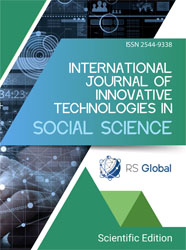SEMANTICS OF ADVERBS IN THE LANGUAGE SYSTEM
Abstract
It is the grouping of words that make up the vocabulary of the language on the basis of their meaning, form, and functions. It is considered parts of speech that words form various groups according to their semantic, morphological, and syntactic signs. In modern linguistics, parts of speech are classified into various: main (autocemantic) parts of speech: noun, adjective, numeral, pronoun, verb, adverb; auxiliary (synsemantic) parts of speech: conjunction, particle; exclamation, imitative, and vocative words. The history of training on parts of speech is very ancient. According to Aflatun, according to ancient Greek scholars, who distinguished the verb from the names back in the fifth century BC, the sentence was corrected as a result of the connection of these names with the verbs. In Alexandrian period grammars, the amount of parts of speech has been increased to eight (name, verb, verb adjective, article, pronoun, adverb, affix, conjunction). In Alexandrian grammars, they have tried to interpret parts of speech morphologically rather than syntactically. In the linguistics of ancient times, the classification of parts of speech was actually subordinated to logic: parts of speech were identified with members of the sentence, which were considered equal to members of the sentence, hence the logical categories. However, at least in part in that classification, it was differentiated based on the presence of grammatical forms and meanings. Until the middle of the XIX century, parts of speech in linguistics were interpreted as a logical grammatical category. In the nineteenth century, linguistics in general, especially the field of morphology, developed a lot. During this period, many and various languages are studied, and as a result, the question arises: on the basis of what criteria it is necessary to classify parts of speech, are there differences in parts of speech in different languages, if so, what are they? At that time, the morphological principle was taken as the main criterion for parts of speech. Such a formal-morphological approach to the problem of parts of speech. It is characteristic of Jespersen’s research. He considered parts of speech to be “formal groups of words”, taking as the main criterion whether they have a verbal form or not. In this respect, he grouped the words as follows: words that are spoken, words that are conjugated, words that are not spoken, and words that are not conjugated.
References
Абаев В.И. Выступление на дискуссии по вопросам омонимии / В.И. Абаев // Лексикографический сборник, вып. IV. – М.: Гос. Изд-во иностранных и национальных словарей, 1960. – С. 71-76.
Ахманова О.С. Очерки по общей и русской лексикологии / О.С. Ахманова. – М.: Учпедгиз, 1957. – 294 с.
Арнольд, И. В. Семантическая структура слова в современном английском языке и методика ее исследования: дис. ... д-ра филос. наук / Арнольд И. В. – Л., 1966.
Виноградов, В. В. Русский язык: Грамматическое учение о слове / В. В. Виноградов. – М., 1972.
Кодухов В.И. Введение в языкознание: Учеб. для студентов пед. интов по спец. № 2101 “Рус. яз. и лит.” – 2-е изд., перераб. и доп. / В.И. Кодухов. – М: Просвещение, 1987. – 288 с.
Потебня, А. А. Из записок по русской грамматике: в 4 т. / А. А. Потебня. – М.: Наука, 1959. – Т. 1.
Современный русский язык: учеб. для бакалавров / П. А. Лекант, Е. И. Диброва, Л. Л. Касаткин, Е. В. Клобуков; под ред. П. А. Леканта. – 5-е изд. – М.: Юрайт, 2013.
Смирницкий, А. И. Лексикология английского языка / А. И. Смирницкий. – М.: Изд-во лит. на иностр. яз., 1956.
Щерба, Л. В. Избранные работы по языкознанию и фонетике: в 2 т. / Л. В. Щерба; отв. ред. М. И. Матусевич; Ленингр. гос. ун-т им. А. А. Жданова. – Л.: Изд-во ЛГУ, 1958. – Т. 1.
Шмелев Д.Н. Очерки по семасиологии русского языка / Д.Н. Шмелев. – М.: Просвещение, 1964. – 425 с.
Яковлюк, А. Н. Лексико-семантический вариант как связующее звено между многозначным словом в языке и его реализацией в речи / А. Н. Яковлюк // Вестник Челябинского государственного университета. Серия «Филология. Искусствоведение». – Челябинск, 2009. – Вып. 36, № 34 (172).
Bauer L. English Word-Formation / L. Bauer. – Cambridge, 1983. – 311 p.
Cruse D. Lexical Semantics / D. Cruse. – Cambridge: University Press, 1986. – Р. 20-40.
Givon T. On Understanding Grammar / T. Givon. – NY: Academic Press, 1979. – 379 p.
Haspelmath M. From space to time: Temporal adverbials in the world’s languages / M. Haspelmath. – Munich & Newcastle: Lincom Europa, 1997. – 181 p.
Jespersen O. Essentials of English Grammer / O. Jespersen. – London, 1946. – 387 p.
Lakoff G., Johnson M. Metaphors We Live By / G. Lakoff, M. Johnson. – Chicago: University of Chicago Press, 1980. – 256 p.
Lehrer A. Polysemy, Conventionality, and the Structure of the Lexicon / A. Lehrer // Cognitive Linguistics. – 1990. – P. 207-246.
Lyons J. Language and Linguistics. An Introduction / J. Lyons. – Cambridge, 1981. – 356 p
Palmer F.R. Semantics. A New Outline / F.R. Palmer. – Cambridge: CUP, 1976. – 164 p.
Views:
409
Downloads:
206
Copyright (c) 2022 Huseynova Tarana Akhmad, Huseynova Rena Kazım

This work is licensed under a Creative Commons Attribution 4.0 International License.
All articles are published in open-access and licensed under a Creative Commons Attribution 4.0 International License (CC BY 4.0). Hence, authors retain copyright to the content of the articles.
CC BY 4.0 License allows content to be copied, adapted, displayed, distributed, re-published or otherwise re-used for any purpose including for adaptation and commercial use provided the content is attributed.











